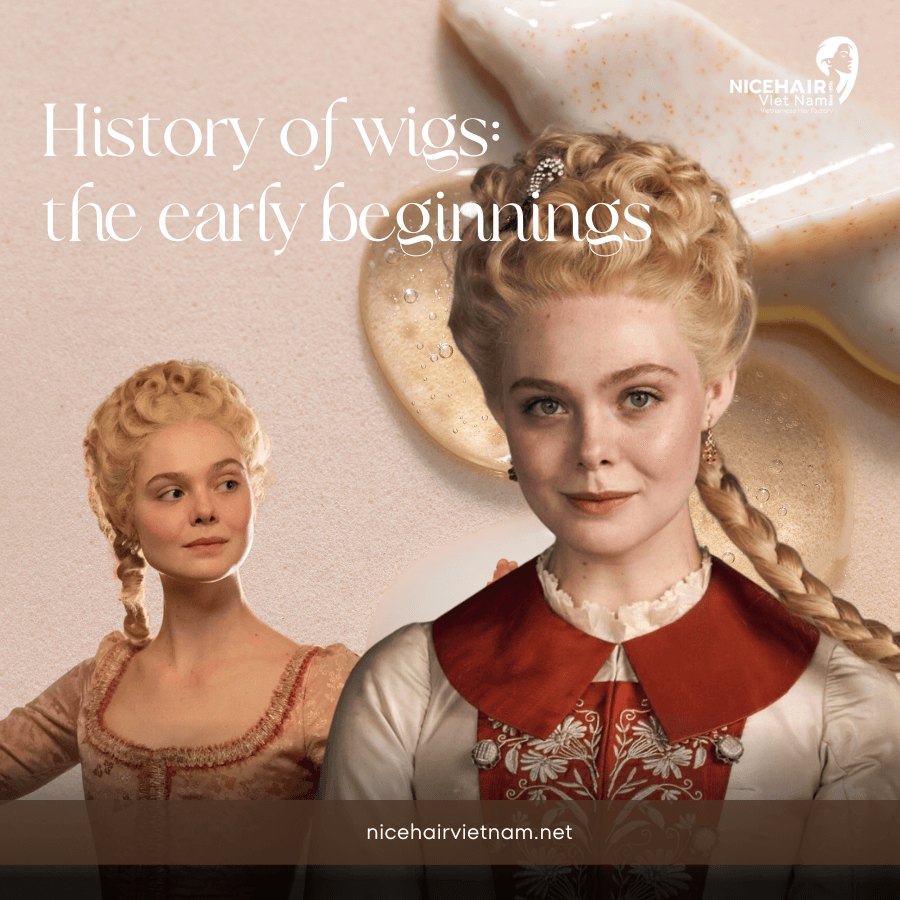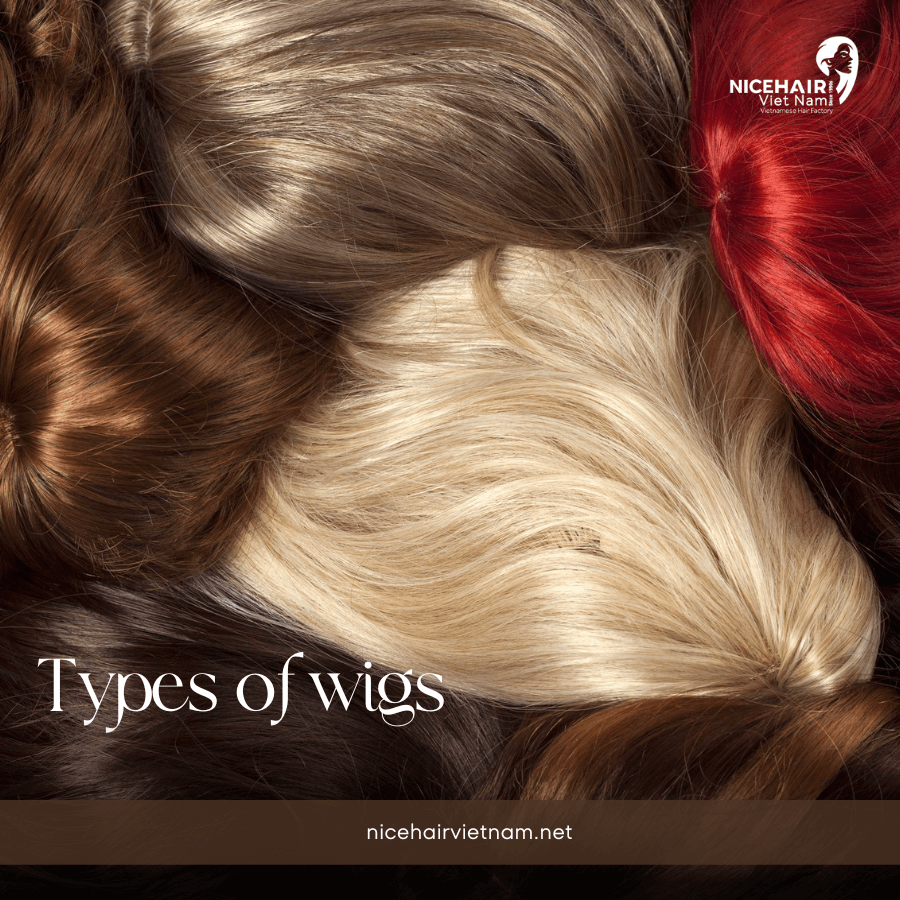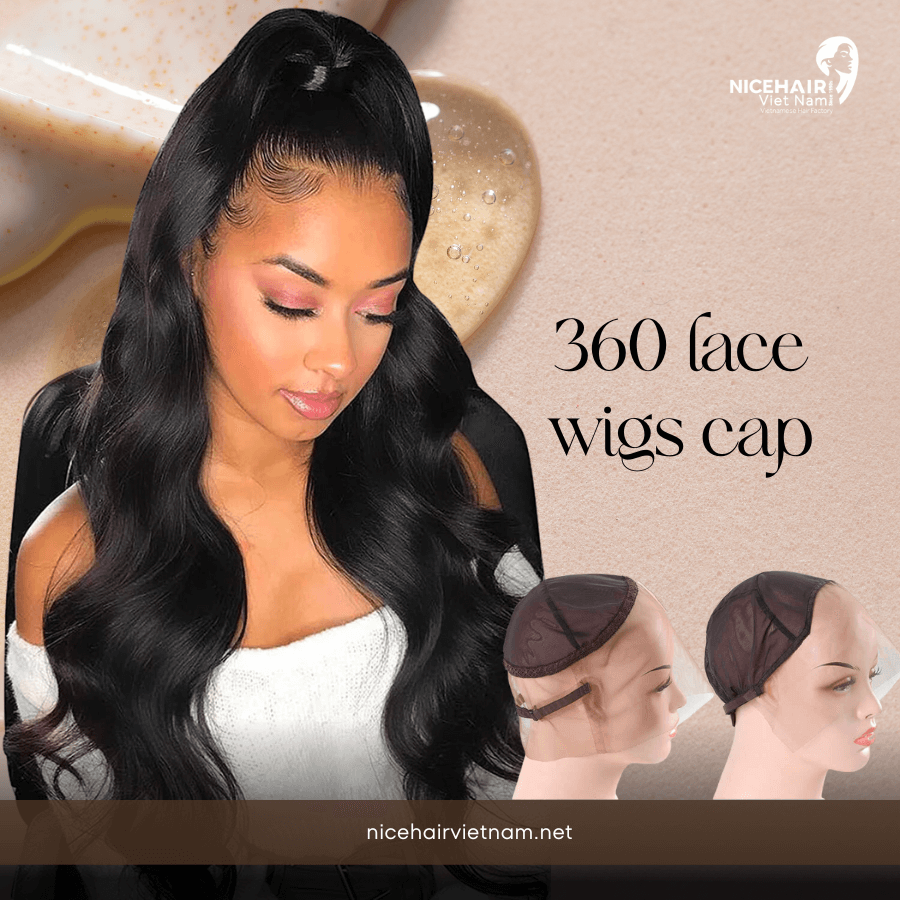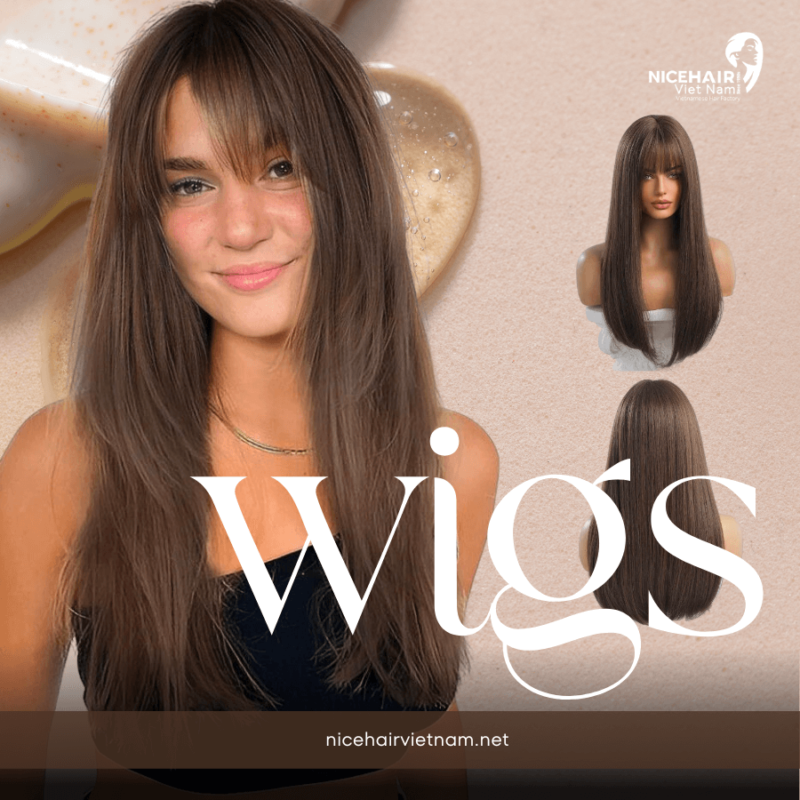The history of wigs has been a part of human culture for centuries, serving various purposes throughout history. From ancient Egypt to modern times, wigs have been used for a variety of reasons, including fashion, religion, and medical purposes. From practicality to fashion, wigs have played a significant role in different societies and have seen their evolution in design, materials, and styles. In this article, we will delve into the captivating history of wigs, exploring their origins, cultural significance, and transformation over time. So, let’s embark on a journey through the ages to uncover the secrets behind the fascinating history of wigs.
History of wigs: the early beginnings
The history of wigs dates back to ancient civilizations, where they first emerged as a practical solution to combat hair loss and protect the scalp from the scorching sun. The first documented use of wigs dates back to ancient Egypt around 3400 BC. Egyptians wore wigs made of human hair, vegetable fibers, and sheep’s wool. Wigs were often attached using beeswax and were usually worn for ceremonial purposes. Thick hair on the head was seen as a status symbol, and wigs were worn by both men and women who were higher up in society, including politicians, pharaohs, and queens.
Wigs in Europe
The history of wigs became popular in Europe during the 16th century. Queen Elizabeth I was known for her iconic red hair, which was likely enhanced using wigs and hair extensions. Wigs were also popular among men during this time, and they were often made of horsehair or human hair. Wigs were seen as a symbol of wealth and status, and they were worn by the upper classes.
The ancient Greeks and Romans embraced wigs as well, albeit for different reasons. In ancient Rome, wigs known as “caps” were commonly worn by women to imitate the hairstyles of the wealthier classes. These wigs were made from hair imported from India and were meticulously styled to achieve the desired look. Similarly, in ancient Greece, wigs were an integral part of theatrical performances, helping actors portray various characters more convincingly.
Renaissance and Baroque periods
During the Renaissance and Baroque periods, wigs experienced a resurgence in popularity. Both men and women of high social status wore elaborate wigs as a symbol of wealth and power. These wigs were often made from human or horsehair and were intricately styled into towering structures adorned with ribbons, feathers, and other ornamental accessories. The extravagance of these wigs reached its peak in the 17th and 18th centuries, reflecting the opulence of the era.
Wigs in the 18 and 19th century
The 18th century witnessed the zenith of wig fashion, wigs became even more popular in Europe. Wigs became an essential accessory for both men and women, with elaborate styles and towering heights. In the courts of Europe, wigs were a signifier of nobility and were worn by monarchs, aristocrats, and even the upper middle class. These wigs were made of human hair and were often powdered with flour or starch to give them a white or gray appearance. They were crafted by skilled wigmakers who meticulously styled and maintained them.
As the 19th century dawned, the popularity history of wigs gradually declined. A shift in fashion and societal norms led to more natural hairstyles gaining prominence. Wearing wigs became associated with the old-fashioned and the conservative, and people began to opt for simpler, more modest hairstyles. By the mid-19th century, wigs had largely fallen out of fashion, with their usage limited to specific professions such as judges and barristers.

The revival history of wigs in the Modern era
The history of wigs although lost their mainstream appeal, they continued to serve practical purposes in certain professions and theatrical performances. In the late 20th century, wigs experienced a revival in the entertainment industry, particularly in the realm of drag performances and costume parties. Wigs became a means of self-expression and allowed individuals to experiment with different looks and styles.
They are also used in the entertainment industry, for medical purposes, and as a fashion accessory. Wigs are made of a variety of materials, including human hair, synthetic fibers, and animal hair. They come in a variety of styles and colors, and they can be customized to fit the wearer’s needs
The history of wigs in contemporary fashion and entertainment industries
Wigs have transcended their historical significance and continue to play a significant role in contemporary fashion and the entertainment industry. With their versatility and transformative capabilities, wigs have become an integral part of creative expression and self-reinvention. In this section, we will explore the fascinating role wigs play in these modern contexts, highlighting their impact on fashion trends, celebrity culture, and the entertainment world.
History of wigs in fashion
Embracing versatility and experimentation
In the realm of fashion, wigs offer endless possibilities for experimentation and self-expression. Designers, stylists, and fashion enthusiasts turn to wigs as a tool to create innovative and boundary-pushing looks on the runway and in editorial shoots. Wigs allow for quick changes in hairstyle, color, and length without committing to permanent alterations. This flexibility empowers designers and individuals to explore diverse aesthetics and push the boundaries of conventional beauty standards.
Influencing trendsetting styles
Wigs have also become trendsetters, inspiring popular hairstyles and influencing the beauty industry. Celebrities and social media influencers often don wigs to showcase new looks, effortlessly transitioning from sleek bobs to cascading curls or vibrant colored tresses. Through their influential presence, wigs shape the ever-changing landscape of fashion and inspire individuals to embrace their creativity.
History of wigs: empowering self-expression
For individuals seeking personal style transformations, wigs offer a transformative experience. Whether it’s for a special occasion or daily fashion choices, wigs provide an opportunity to experiment with different personas, embrace alternative identities, or simply enhance one’s natural beauty. Wigs empower individuals to express their unique sense of style and confidently navigate the fashion world.

History of wigs in the entertainment industry
Enabling character transformations
Wigs have long been essential tools in the entertainment industry, enabling actors, performers, and artists to embody characters convincingly. Whether it’s a period drama, a fantasy epic, or a science fiction spectacle, wigs play a pivotal role in creating authentic and visually captivating characters. With the ability to change hairstyles, colors, and textures effortlessly, wigs enhance the storytelling experience, bringing characters to life and immersing audiences in fantastical worlds.
Enhancing performance and stage presence
In the realm of live performances, wigs take center stage, amplifying the impact of costumes and choreography. From theatrical productions to music concerts, wigs are used to enhance performers’ stage presence and evoke specific emotions. Elaborate, larger-than-life wigs can captivate audiences, adding an element of grandeur and spectacle to the performance.
History of wigs: facilitating time and styling constraints
In the fast-paced world of entertainment, time is often a precious resource. Wigs provide a practical solution by reducing the time required for hairstyling and allowing performers to effortlessly switch between different looks during performances or shoots. This efficiency enables seamless transitions and ensures that artists can embody multiple characters or personas without the need for extensive hairstyling between scenes.
Types of wigs
Wigs have become a popular choice for individuals seeking versatility and creative expression with their hairstyles. Whether you want to change your look, add volume, or conceal hair loss, there is a wide range of wig types available to suit your needs. In the development history of wigs, there are many types, let’s find out through the prominent names.
Natural-looking wigs: With advancements in wig-making techniques and materials, natural-looking wigs have become highly sought after. These wigs are made with high-quality human hair or synthetic fibers that mimic the texture, color, and movement of natural hair. They are popular among celebrities and models who want to change their hairstyle without damaging their own hair.
Glueless Wigs
What are glueless wigs?
Glueless wigs are wigs that do not require adhesive or glue to be secured to the scalp. They are designed with adjustable straps and combs inside the cap to ensure a secure fit without the need for glue.
Glueless wigs are easy to wear and remove, making them a convenient option for those who prefer not to use adhesive products on their scalp. They are also beginner-friendly and can be quickly put on and taken off.
These wigs are often made with high-quality human hair or synthetic fibers and come in various styles, lengths, and textures. They provide a natural-looking appearance and can be styled just like natural hair.
Headband Wigs
What are headband wigs?
Headband wigs are a type of wig that features a headband attached to the front or top of the wig. The headband is usually made of fabric or elastic material and is used to secure the wig in place.
These wigs are designed to be worn with the headband covering the hairline, giving the illusion of a natural hairline. They are popular for their easy and quick installation, as there is no need for lace or glue. Headband wigs are versatile and can be styled in various ways. The headband can be adjusted or replaced with different headbands to match different outfits or personal preferences.
They are often made with human hair or high-quality synthetic fibers to provide a realistic look and feel. Headband wigs are a great option for those who want a hassle-free and comfortable wig-wearing experience.
Both glueless wigs and headband wigs offer convenience and ease of use. They eliminate the need for adhesive products and provide a secure fit. Whether you prefer a wig without glue or a wig with an attached headband, these options offer versatility and a natural-looking appearance.

Full lace wigs
What are full lace wigs?
They are a type of wig that provides maximum versatility and a natural-looking appearance. These wigs are constructed with a sheer lace cap that covers the entire head, allowing for a seamless blend with the wearer’s scalp. The lace material is soft, breathable, and virtually undetectable, giving the illusion of hair growing directly from the scalp.
- Construction: Full lace wigs are constructed with a lace cap that covers the entire head. The lace material is usually made of Swiss or French lace and is very thin and lightweight. Each strand of hair is individually tied to the lace cap, which gives the wig a natural-looking appearance.
- Versatility: Full lace wigs are versatile and can be styled in various ways. They can be parted in any direction, pulled back into a ponytail, or styled into an updo. The lace material also allows for a natural-looking hairline, which makes the wig look like natural hair.
- Comfort: Full lace wigs are comfortable to wear and provide a secure fit. The lace material is breathable and lightweight, which makes it comfortable to wear for extended periods of time. The wig can also be adjusted to fit the wearer’s head size.
- Quality: Full lace wigs are often made with high-quality human hair or synthetic fibers. Human hair wigs are more expensive but provide a more natural-looking appearance and can be styled just like natural hair. Synthetic wigs are more affordable but may not look as natural as human hair wigs.
- Maintenance: Full lace wigs require regular maintenance to keep them looking their best. They should be washed and conditioned regularly, and the lace should be cleaned to prevent buildup. The wig should also be stored properly when not in use.
Overall, full lace wigs are a popular option for those who want a natural-looking wig that can be styled in various ways. They are comfortable to wear and provide a secure fit. Whether you prefer human hair or synthetic fibers, full lace wigs offer versatility and quality.

Lace front wigs
Lace front wigs are a popular type of wig that features a sheer lace material at the front of the wig. Here are some key features of lace front wigs:
- Construction: Lace front wigs are constructed with a sheer lace material at the front of the wig. The lace material is almost invisible and is designed to mimic the natural hairline. Each strand of hair is individually hand-tied to the lace material, which gives the wig a natural-looking appearance.
- Versatility: Lace front wigs are versatile and can be styled in various ways. They can be parted in any direction, pulled back into a ponytail, or styled into an updo. The lace material also allows for a natural-looking hairline, which makes the wig look like natural hair.
- Quality: Lace front wigs are often made with high-quality human hair or synthetic fibers. Human hair wigs are more expensive but provide a more natural-looking appearance and can be styled just like natural hair. Synthetic wigs are more affordable but may not look as natural as human hair wigs.
- Comfort: Lace front wigs are comfortable to wear and provide a secure fit. The lace material is breathable and lightweight, which makes it comfortable to wear for extended periods of time. The wig can also be adjusted to fit the wearer’s head size.
- Maintenance: Lace front wigs require regular maintenance to keep them looking their best. They should be washed and conditioned regularly, and the lace should be cleaned to prevent buildup. The wig should also be stored properly when not in use.
Overall, lace front wigs are a popular option for those who want a natural-looking wig that can be styled in various ways. They are comfortable to wear and provide a secure fit. Whether you prefer human hair or synthetic fibers, lace front wigs offer versatility and quality.
360 lace wigs
What are 360 lace wigs?
360 lace wigs are a type of wig that combines the features of both full lace wigs and lace front wigs. Here are some key points about 360 lace wigs:
- Construction: 360 lace wigs are pre-sewn with a 360 frontal and bundles. They have lace all around, with 4.5 inches of front lace and 1-1.5 inches of lace at the back. The lace allows for a natural-looking hairline and the ability to part the hair in any direction.
- Versatility: With the lace all around, 360 lace wigs offer versatility in styling. They can be pulled back into a ponytail or styled into an updo, giving a natural appearance at the hairline.
- Comfort: 360 lace wigs are designed to be comfortable to wear. The lace material is breathable and lightweight, allowing for airflow to the scalp.
- Quality: 360 lace wigs are often made with high-quality human hair or synthetic fibers. Human hair wigs provide a natural-looking appearance and can be styled like natural hair, while synthetic wigs are more affordable but may not look as natural.
- Easy installation: 360 lace wigs are relatively easy to install compared to full lace wigs. The wig comes with the frontal already sewn in, which eliminates the need for additional sewing or gluing.
- Edge coverage: One of the advantages of 360 lace wigs is that they provide full coverage around the perimeter of the head, including the edges. This eliminates the need to worry about the edges showing and allows for a seamless and natural look.
Overall, 360 lace wigs offer a combination of the natural-looking hairline and versatility of lace front wigs, along with the full coverage and comfort of full lace wigs. They are a popular choice for those who want a wig that provides a natural appearance and styling options.

U-part wigs
U-part wigs are a type of wig that allows the wearer to blend their natural hair with the wig for a seamless look. Here are some key features of U-part wigs:
- Construction: U-part wigs are constructed with a U-shaped opening at the front that allows the wearer to blend their natural hair with the wig. The wig is sewn onto a U-shaped wig cap with clips along the part. The cut out in the front allows wearers to pull out pieces of their natural hair to blend with the wig.
- Versatility: U-part wigs are versatile and can be styled in various ways. They can be parted in any direction and styled to match the wearer’s natural hair. The U-shaped opening also allows for a natural-looking hairline, which makes the wig look like natural hair.
- Quality: U-part wigs are often made with high-quality human hair or synthetic fibers. Human hair wigs provide a natural-looking appearance and can be styled like natural hair, while synthetic wigs are more affordable but may not look as natural.
- Easy installation: U-part wigs are relatively easy to install compared to full lace wigs. The wig comes with the U-shaped opening already sewn in, which eliminates the need for additional sewing or gluing.
- Comfort: U-part wigs are designed to be comfortable to wear. The wig cap is breathable and lightweight, allowing for airflow to the scalp.
- Maintenance: U-part wigs require regular maintenance to keep them looking their best. They should be washed and conditioned regularly, and the wig cap should be cleaned to prevent buildup. The wig should also be stored properly when not in use.
Overall, U-part wigs offer a natural-looking appearance and versatility in styling. They are comfortable to wear and provide a secure fit. Whether you prefer human hair or synthetic fibers, U-part wigs offer quality and convenience.
History of wigs in building confidence
Wig shame is a real phenomenon that affects many people who wear wigs. People may feel embarrassed or ashamed to wear wigs in public due to societal stigmas and negative attitudes towards wigs.This can have a negative impact on a person’s self-esteem and confidence, preventing them from expressing themselves and feeling comfortable in their own.
To build confidence when wearing a wig, people can try different styles and hairstyles and have some fun with their wig. They can choose the right wig that fits perfectly atop their head and complements their features. Wearing the wig at home and going out in public can also help build confidence. Properly caring for the wig will help it look its best and prevent it from becoming damaged or tangled, which will help people feel more confident wearing their wigs.

Overall, building confidence when wearing a wig is a personal journey, and it takes time and practice. Wearing a wig for the first time can be overwhelming and daunting, but there are ways to build your confidence and feel comfortable in your wig. By choosing the right wig, wearing it at home, and practicing wearing it in public. Remember to believe in yourself and compliment yourself daily to feel your best. In the journey of creating more history of wigs, the team at nicehairvietnam-net-492844.hostingersite.com is here to help you find out the best hairstyle and quality wigs.
Contact us
Website: nicehairvietnam.com
Whatsapp: (+84) 846009647
Email: hakan@nicehairvietnam.com
Factory address: Factory No1, Dong Tho’s Street Zone, Yen Phong Dist., Bac Ninh Province, Vietnam.
Office: No.25 Tho Thap Ward, Dich Vong Hau Ward, Cau Giay District, Hanoi City, Viet Nam.

